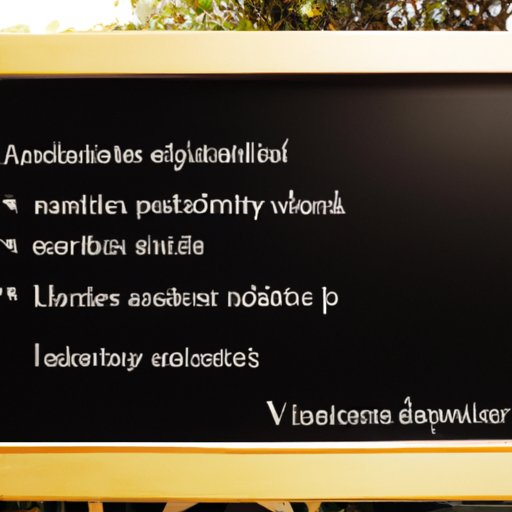Introduction
Romance in literature is a genre that has been around for centuries, and its themes and representations have evolved over time. Romance is a type of fictional narrative that focuses on the development of a romantic relationship between two characters. This can include traditional love stories, non-traditional romances, and even stories that subvert expectations. In this article, we will explore the various ways romance has been portrayed in literature throughout history, analyze how popular authors have incorporated it into their works, and discuss the impact it has on readers.
Analyzing the Evolution of Romance in Literature Throughout History
Romance as a genre has been around since ancient times, though the way it has been portrayed has changed significantly over the centuries. Early examples of romance in literature can be found in Greek and Roman mythology, such as the story of Pyramus and Thisbe, which was later retold by Ovid in Metamorphoses. These tales often featured epic journeys, supernatural elements, and star-crossed lovers who were thwarted by fate.
Over the years, romantic stories have become more realistic and relatable. Themes such as forbidden love and unrequited love are still present, but they are often presented in a more nuanced way. For example, Jane Austen’s Pride and Prejudice features characters whose class differences complicate their relationship, while William Shakespeare’s Romeo and Juliet explore the consequences of family feuds. More recent works, such as J.K. Rowling’s Harry Potter series, feature complex relationships between characters of different backgrounds and ages.

Comparing and Contrasting Different Types of Romance in Literature
Romantic stories come in many forms, from traditional love stories to more unconventional narratives. Traditional love stories typically follow a predictable formula, with two characters falling in love despite obstacles in their way. These stories often have a happy ending, with the couple overcoming all odds to be together. Examples of traditional love stories include Jane Austen’s Sense and Sensibility and the classic fairy tale Cinderella.
Non-traditional romances challenge the conventions of traditional love stories. They may focus on characters who do not fit into one mold, such as interracial couples or same-sex couples. They may also feature characters who are not looking for love, or who are struggling with personal issues. Examples of non-traditional romances include Toni Morrison’s Beloved and Chimamanda Ngozi Adichie’s Americanah.
Another type of romance in literature is the subversion of expectations. These stories often involve characters who defy societal norms and break away from traditional gender roles. Examples of this type of romance include Margaret Atwood’s The Handmaid’s Tale and Charlotte Bronte’s Jane Eyre.

Examining How Popular Authors Portray Romance in their Works
Many authors have explored the theme of romance in their works. Jane Austen’s Pride and Prejudice is perhaps the most iconic example of a traditional love story. The novel follows the courtship between Elizabeth Bennet and Mr. Darcy, two characters from very different backgrounds who must overcome their pride and prejudice in order to be together. Austen’s use of wit and social commentary make her novel a timeless classic.
William Shakespeare’s Romeo and Juliet is another classic example of a romantic story. The play follows the tragic love affair between two young lovers from rival families, and their struggle against the social conventions of their time. Shakespeare’s use of language and symbolism makes his work as relevant today as it was when it was first written.
The Harry Potter series by J.K. Rowling also includes romance as a major theme. The books feature several relationships, including the budding romance between the protagonists Harry and Ginny Weasley. Rowling’s use of magical elements and fantasy settings make her novels a unique take on the traditional love story.

Exploring the Impact of Romance on the Reader
Romance in literature has a powerful effect on readers. Many people connect emotionally with the characters in romantic stories, feeling joy when they triumph and sorrow when they suffer. By reading about the struggles of romantic relationships, readers can gain insight into their own lives and relationships.
Romantic stories can also provide an escape from the real world. Reading about characters overcoming obstacles to be together can give readers hope and optimism. This can be especially true for readers who feel isolated or marginalized in their own lives.
Finally, romantic stories can serve as a form of social commentary. Through the exploration of power dynamics in relationships, authors can address issues such as gender roles and social status. This can help readers better understand the complexities of human relationships and society at large.
Discussing the Power Dynamics of Romantic Relationships in Literature
Romantic relationships in literature often reflect the power dynamics of real-life relationships. Gender roles are often portrayed in a traditional manner, with men being portrayed as strong and assertive and women being portrayed as passive and submissive. This can limit the reader’s understanding of gender roles and reinforce stereotypes.
Social status can also be a factor in romantic relationships in literature. Characters from higher social classes may be shown as having greater power and privilege than those from lower classes. This can lead to unrealistic expectations and reinforce class divisions.
Finally, agency is often limited in romantic relationships in literature. Characters may be portrayed as sacrificing their autonomy in order to be with the person they love. This can give readers the impression that they should do the same in their own relationships, rather than asserting their own needs and desires.
Investigating How Technology Has Changed the Way We Experience Romance in Literature
In recent years, technology has had a major impact on the way we experience romance in literature. Online dating has made it easier for people to search for potential partners, and social media has allowed us to keep in touch with loved ones from afar. Video games have also allowed us to explore relationships in virtual worlds.
These changes have had both positive and negative effects on romance in literature. On the one hand, technology has made it easier for people to find love and stay connected. On the other hand, these technologies can also create unrealistic expectations and make it difficult for people to build meaningful connections.
Conclusion
Romance in literature has evolved over the centuries, and it continues to be a popular genre today. Different authors have portrayed romance in their works in unique ways, exploring the power dynamics of relationships and how technology has impacted them. Romance in literature can have a powerful impact on readers, providing emotional connections, escapism, and social commentary. As the genre progresses, it will be interesting to see how authors continue to explore these themes.
(Note: Is this article not meeting your expectations? Do you have knowledge or insights to share? Unlock new opportunities and expand your reach by joining our authors team. Click Registration to join us and share your expertise with our readers.)
